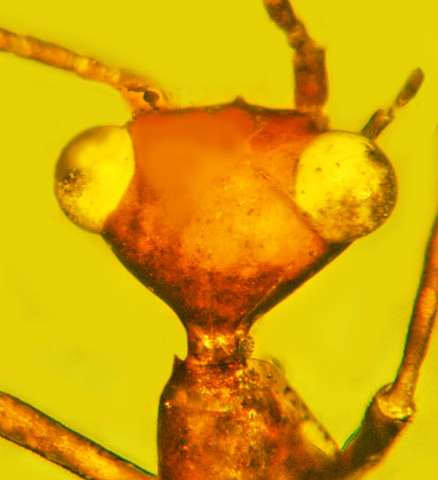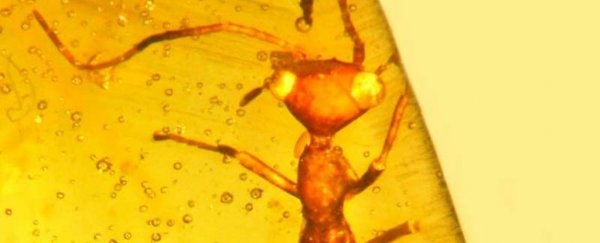Researchers have discovered two 100-million-year old insects trapped in amber that are so unusual, they represent an entire new order of insect.
Finding a whole new order of insect is an extremely rare event, and it brings the total amount of known orders within the class to 32.
The insect, which is now known as Aethiocarenus burmanicus, has alien-like eyes, a triangular head, a long and flat body, and slender legs.
The unusual nature of its characteristics required the creation of a new order - the taxonomic category below class and above family - which the team has called Aethiocarenodea.
"This insect has a number of features that just don't match those of any other insect species that I know," said team member George Poinar Jr., from Oregon State University.
"I had never really seen anything like it. It appears to be unique in the insect world, and after considerable discussion we decided it had to take its place in a new order."
One of the strangest things about the newly found specimen is that its eyes bulge out at the sides, allowing it to look directly behind itself. And special glands on its neck indicate that it might have emitted chemicals to ward off potential predators.
"Other features of the fossil are the long narrow, flat body, long slender legs, especially the hind pair that are twice the length of the abdomen, lack of wings, protruding eyes, paired ocelli, secretory glands located on the dorsum of the neck and swollen abdomen bearing paired segmented cerci," the team reports.
Here's what the neck glands look like, up close and personal:
 Oregon State University
Oregon State University
The team says the specimen – which is presumed to be extinct seeing as it's only known from these amber samples – was most likely an omnivore from the ancient forms of Burma some 100 million years ago.
Its extinction was sudden, and the cause remains a mystery.
When it was alive, the insect spent most of its time scurrying up trees, where it likely ate fungi, mites, and worms.
"The strangest thing about this insect is that the head looked so much like the way aliens are often portrayed," said Poinar.
"With its long neck, big eyes and strange oblong head, I thought it resembled E.T. I even made a Halloween mask that resembled the head of this insect. But when I wore the mask when trick-or-treaters came by, it scared the little kids so much I took it off."
Before the recent discovery, scientists knew of about 1 million different insect species belonging to 31 different orders.
The largest order, Coleoptera, contains hundreds of thousands of known species, including beetles and weevils.
It will take more research for scientists to fully understand the new insect, such as how long it lived, what caused it to go extinct, and if there are any other species inside the new order.
The team's work was published in Cretaceous Research.
